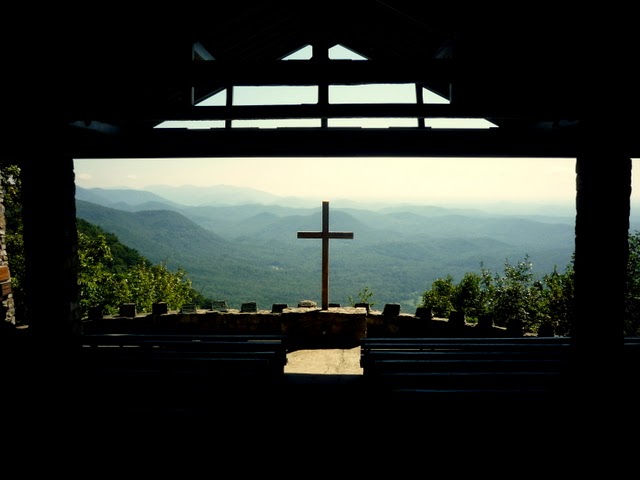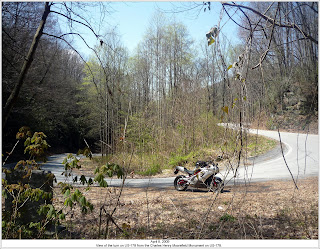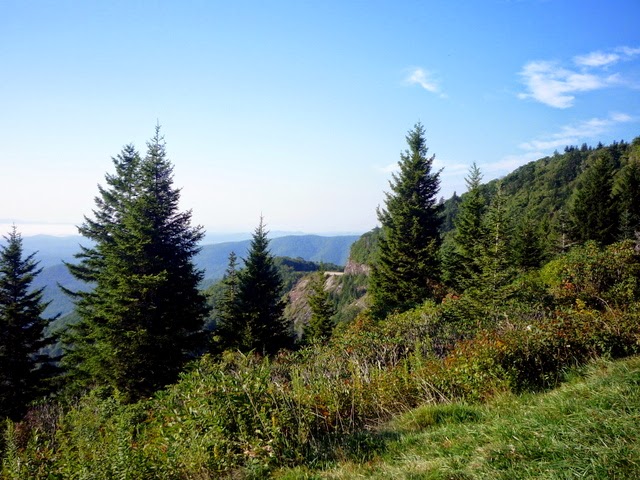.
I don't have experience riding in very many places, but I do pay attention to some of the online blogs and forums, that, on occasion, speak about beautiful and challenging roads across the world.
Some of the best roads in the eyes of a few of these posters -- and in my view -- are right in my back yard here in the Carolinas. How opportune it was that I moved to South Carolina just a few years before starting to ride my two-wheeled machine. I say that because I used to live in areas that were much flatter and less picturesque. The cyclists of all kinds there don't use the sides of their tires very much. We have quite an opportunity to do so if we want, around these parts.
All I have to do is leave my garage, and ride about 52 miles on progressively more technical roads to get to the closest point of the
Blue Ridge Parkway, the subject of my tome today.
I'm talking about a couple of other good roads, US-178 and NC-215, to get there. I have ridden these roads many times. The best part of US-178 starts with some mild curves just north of Pickens South Carolina. That stretch is where the
Perfect Curve lives.
Once you reach SC-11, about nine miles north from Pickens, the road shortly becomes much more twisty. There are two second gear turns for me, and many best handled in third gear. The road surface is generally good except for some breaks and settling in a few of the many fills that made the road possible. The sight distances are reasonable in many places -- but not all -- so you can
look ahead as you should to properly navigate the turns.
One especially interesting and entertaining
series of S curves is just south of Rocky Bottom. I have become a bit bolder when navigating this section over the years, and I never cease to be amazed by how sticky my Michelin Pilot Road 3 and 4 street tires can be. I am sure, too, though, that
I am not riding to the max on them.
US-178 was designed under one
Charles Henry Moorefield, South Carolina state highway engineer between 1920 and 1935. Granite markers are scattered along the right of way giving him tribute, like this one near the North Carolina state line:
On this curve:
In about 26 miles from Pickens, you reach Rosman North Carolina where a gas station and food market await for a short rest. From Rosman, you take NC-215 further north.
This road is about as twisty as the sections of 178 between SC-11 and Rosman, and the pavement has recently been renewed with a fresh layer of uniform color and surface blacktop, so it is a smooth ride.
As an aside, the color of the surface has a significant effect on your ability to discern hazards like loose gravel. Some other roads, not-too-far-away
SC-28 and SC-107, to the west, have stretches where chip and stone has been applied, making the surface an irregular mix of white and black that is confusing to the eye.
Some riders just ignore that and blast on through, but I slow down just in case there is a section of real loose stuff, especially in a curve.
The remaining 10-1/2 miles to the Parkway pass in a matter of a couple of minutes it seems. Soon enough I make the entrance turn to the left just after passing under the Parkway through this picturesque stone arch.
On a historical note, I have traveled the Parkway some forty times since my first venture there on the bike in April of 2008, about seven months after I started riding.
[Ya' like that road, huh, Bucky?]
My latest trip on the Parkway was on August 30
. I had the route marked out to ride with one of the
new guys, but he couldn't go because of some bike mechanical trouble. Previously, the new guy, Chris, went with me on a ride that included
SC-130, SC-107, and SC-28, and again on a ride that included the
Greenville Watershed road to Saluda North Carolina. This ride to the Parkway would have been the next step in difficulty.
I decided to go it alone, when I learned that he could not go. We will do it again when he gets his bike back on the road.
Once I hit the Parkway, I turn south and travel to the highest point, about 8-1/2 miles from 215. The requisite picture is taken in front of the highest-point sign. The day is beautiful, with brilliant blue skys, painted artistically with occasional clouds.
I gaze at the scenery then mount up for the trip back toward 215 and beyond.
I think the section of the Parkway between
Waterrock Knob and Asheville is quite
picturesque, and the road is just challenging enough to make it interesting.
I travel along, stopping occasionally to gawk at the scenery, so my overall pace is pretty sedate. There is no commercial traffic on the Parkway, so you don't have to watch for semis hogging both lanes. There are few cross roads, but you do have to watch for the overlook entrances that are, many times, blind around curves: Traffic crossing your lane sometimes can't see you coming.
One thing that irritates me on the Parkway is drivers who stop to look at the scenery without pulling off the road. This happens quite often on the Parkway. They don't seem to realize that people can't see them from around a bend, and don't expect someone to be stopped dead in the road. Come to think of it, they could
become dead in the road, if they act like that. This time around, it is a bicyclist who is stopped with his bike across the other lane, photographing three women standing on the berm on my side, with the mountains as backdrop. I am sure it will make a mighty pretty picture. They scatter with a few blasts of the horn, fortunately. I just don't know about peoples' judgment. Maybe his helmet is too tight.
I pass the Mt.
Pisgah Inn and other points of interest, and go through several tunnels of varying lengths.
You have to watch for bicyclists in the tunnels. Some of them don't have reflectors or lights.
Finally the French Broad River comes into view on the right. I stop for a few minutes to take it all in.
By the way, the river down below me was named by settlers centuries ago because it was one of the two broad rivers in western North Carolina. The one that flowed into land claimed by France at that time was named the French Broad River, whereas the other, which stayed in land claimed by England - the Colony of North Carolina - was named the English Broad River, later renamed simply the Broad River.
Unfortunately, this marks the end of my travel on the Parkway today.
I could go on for another ten miles or so to the
Parkway Visitor Center, or could go much further to Black Mountain and beyond. I have ridden as far as Boone on the bike, and there are some nice sections through there as well.
 |
| Click here for interactive map. |
Or, I could double back to, say, US-276 and go back down the Blue Ridge Escarpment that way.
 |
| Click here for interactive map. |
That route starts out very twisty, and would take me past the
Cradle of Forestry where they chronicle the history of forest management, through
Dupont Forest, a good place for hiking and mountain biking, and past
Caesar's Head, a high point with a great view, then through another very twisty section.
...but I don't today. I don't have a lot more time left, so I exit the Parkway, onto NC-191, paralleling the river, then cut to over a short distance to I-26. This is a quick (but boring) way to get home, taking I-26, US-25, SC-11, SC-8, SC-135, though those last three are a little more interesting than 26 and 25.
This is the route I took, about 180 miles:
 |
| Click here for an interactive map. |
Although I went only 46 miles including 8 miles I traveled in both directions on the Parkway today, the total length of the Parkway is 469, so there is plenty more to explore.
But I like this stretch just about best, though.
Here is a scattering of pictures from previous trips on the Parkway:
 |
| My first trip on the Parkway. |
 |
| Photo of curve advisory sign by Ryan. |
 |
| French Broad River overlook. |
Come and join me some time for an exceptionally good ride on
one of the great roads in the United States.
By the way, what is your favorite road?
More info:
- Rally to Ridgecrest 2013 -- Day 1
- Rally to Ridgecrest 2013 -- Day 2
- Rally to Ridgecrest 2013 -- Days 3 and 4.
- Freedom is Never Free! -- Rally to Ridgecrest, 2011, Part I
-
Freedom
is Never Free! -- Rally to Ridgecrest, 2011, Part II
- Memorial
Day 2010 Weekend Rally
-
Memorial
Day 2010 Weekend Rally, Part II, The Ride Up
-
Memorial
Day 2010 Weekend Rally, Part III, Saturday
-
Memorial
Day 2010 Weekend Rally, Part IV, Sunday and the Ride Home.
- Ride to Mt. Mitchell -- Highest Point East of the Mississippi
.
.



































